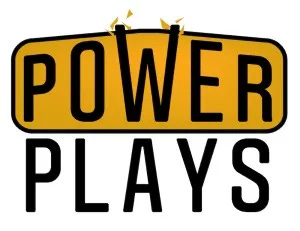Inside the 1st draft for the PWHL, the league that aims to level up women’s hockey
Monday was yet another historic day for women's sports.
Hi, friends. Lindsay here. I’m thrilled to introduce this piece by first-time Power Plays contributor Melissa Burgess, a writer at the Victory Press. You can follow all of Melissa’s hockey coverage on Twitter, @_MelissaBurgess.
I love having freelance contributors to Power Plays, but it does cost money. If you’re interested in supporting more of this work, remember we are running a 27% off sale right now. If you already have a Power Plays subscription, remember that you can gift a subscription or donate a subscription — the 27% off counts for those, too!
Thanks, as always, for your support!
Inside the 1st draft for the PWHL, the league that aims to level up women’s hockey
The inaugural Professional Women’s Hockey League (PWHL) draft was unlike anything we’ve ever seen in professional women’s hockey. The Premier Hockey Federation/National Women’s Hockey League (2015-2023) never held a draft in-person; the Canadian Women’s Hockey League (2007-2018) did hold an in-person draft, but it didn’t rise to this level of experience.
This draft was held at the Canadian Broadcasting Centre headquarters in downtown Toronto. All players who declared for the draft were invited to attend; a select group also received a stipend to attend.
Before the draft itself, players walked the purple carpet, signing autographs for fans and speaking to the media. The vibes? They were great! It was almost like a reunion for some players, and though some of them were certainly nervous, they also seemed excited. Several agencies even set up hair & makeup suites for their players beforehand, adding an extra layer of glitz and glam to the day.
The draft itself was well-run, if a little long! Ninety players, most of whom were in attendance, were selected. An array of special guests announced the picks, from Billie Jean King to Tessa Bonhomme and Cassie Campbell-Pascall. Players didn’t get jerseys after being picked — the league hasn’t unveiled team monikers, colors or logos — but still got the chance to walk up on stage & be photographed. It all genuinely felt special, professional, and truly like nothing we’ve had in women’s hockey before.
But before we dive into the specifics of the draft, let’s take a step back and look at how we got here
What is the PWHL?
The Professional Women’s Hockey League (PWHL) is the new pro women’s hockey league in North America, set to begin play in January 2024 in six cities: Boston, New York, Minnesota, Toronto, Ottawa and Montreal.
The PWHL is led by a board of directors including Billie Jean King, Ilana Kloss, Stan Kasten and Royce Cohen. Mark & Kimbra Walter are the main financial backers behind the new league, which comes on the heels of the group’s buyout of the PHF and the first-ever collective bargaining agreement formed by the Professional Women’s Hockey Players’ Association (PWHPA).
The PWHL, which made history by enacting its first collective bargaining agreement before its inaugural season, is expected to provide a professional environment for the best female hockey players in North America and to help grow the sport of women’s hockey for years to come.
How are team rosters formed?
Players who were interested in being part of the PWHL had to “declare” for the draft by September 3. There was no minimum age requirement, as showcased by a 16-year-old (!) declaring for the draft.
An initial free agency period began September 1, where teams were allowed to sign three players before the draft. Unsurprisingly, general managers stacked their roster with high-caliber talent in these three free agents, with players like Marie-Philip Poulin, Brianne Jenner, Hilary Knight, Kendall Coyne-Schofield, Abby Roque and Sarah Nurse signing.
Players who didn’t get signed as part of that initial round entered the PWHL draft, which was held on September 18 in downtown Toronto. With 15 rounds, a total of 90 players were selected, bringing each team up to a possible 18 players. (Technically, a draftee doesn’t have to sign with the team that selected them. Teams will hold a draftee’s rights for two years, at which time the player can re-enter the draft.)
From here, all undrafted players become free agents and can sign with any team of their choosing. Teams have to bring 28 players to preseason training camp in November, with 23 players ultimately making the final roster for the regular season.
Who else is involved with the PWHL?
Each team has named a general manager and head coach to date. Some teams have also hired scouts and analytics folks, but those hires haven’t necessarily been publicly announced yet. That said, here’s what we know so far:
Boston: Danielle Marmer (GM), Courtney Kessel (HC)
New York: Pascal Daoust (GM), Howie Draper (HC)
Minnesota: Natalie Darwitz (GM), Charlie Burggraf (HC)
Toronto: Gina Kingsbury (GM), Troy Ryan (HC)
Ottawa: Michael Hirshfeld (GM), Carla MacLeod (HC)
Montreal: Danièle Sauvageau (GM), Kori Cheverie (HC)
Who were the top picks?
To absolutely no one’s surprise, forward Taylor Heise went first overall to Minnesota. The 23-year-old was the top-ranked prospect, is a Minnesota native and just finished five seasons at the University, so it’s a natural fit. She’s a dynamic offensive threat with leadership experience — she captained her college team last season and had 65 points in 38 games.
From there, the draft was really open season. With a lot of talent, there were so many ways teams could have gone! Here’s how the rest of the first round went:
Jocelyne Larocque - 2nd overall, Toronto
A skiller defender, Larocque was the first of three Indigenous players to hear their names called on Monday. She skated in 20 PWHPA games last season and has represented Canada internationally at the Olympics & Worlds. At 35, she’s one of the older players in the draft and said she wasn’t sure if she’d still be playing when something like this finally came around. Suffice to say, she’s excited to keep playing in the GTA, having previously skated for the CWHL’s Brampton/Markham Thunder.
Alina Müller - 3rd overall, Boston
This pick came as no surprise, but it’s still a great one for the Boston team. Müller has spent the last five seasons at Northeastern, so she’s already familiar with the city and seemed thrilled to get the chance to keep playing there - this time, as a pro. She led Northeastern with 60 points in 38 games last season & was the first of four Huskies alums to be selected.
Ella Shelton - 4th overall, New York
Shelton going this high was the first “off-the-board” pick. I had her ranked as a Tier IV player; The Athletic’s mock draft had her at #17, and The Ice Garden’s Carlie Markey had her as a tier-two defender. Shelton appeared in 18 games last season in the PWHPA and had nine points; she also has Olympics & Worlds experience.
Savannah Harmon - 5th overall, Ottawa
The trend of selecting defenders continued! Harmon was certainly a top-12 (first two rounds) pick, so it wasn’t surprising to see her go here. The 27-year-old skated in 20 PWHPA games last season and had seven assists. Her national team experience is relatively fresh, having played her first Worlds in 2021 and her first Olympics in 2022.
Erin Ambrose - 6th overall, Montreal
After signing two forwards and a goalie in free agency, Montreal elected to start their draft with a defender to round out the bunch. With several fantastic options, Ambrose is a strong pick and a natural fit. She previously played for Les Canadiennes in the CWHL from 2017-2019 and said playing in Montreal was “a turning point” for her, both in her hockey career and personally.
Overall, a few surprises, and an incredibly heavy defensive first round. Teams really prioritized loading up their bluelines, which makes sense given the sheer amount of offensive talent available. There were 146 forwards available, while only 78 defenders declared for the draft.
Which team had the best draft?
It’d be hard not to argue Boston for this one. They snagged Müller, then managed a steal in Jaques in the second round. Picking up Rattray in the third round was an unexpected bonus. They also drafted Loren Gabel (no surprise there), Hannah Brandt, Jessica Digirolamo, Theresa Schafzahl, Emily Brown, Taylor Girard, Sophie Shirley, Darkangelo, Emma Buckles, Tatum Skaggs and Jess Healey.
Drafting Emma Söderberg to make a goaltending tandem of her & Aerin Frankel? A stroke of genius. Between those two netminders, protected by defenders like Jaques and already-signed Megan Keller, and led by offensive stars like Hilary Knight and Gabel… they’re going to be an incredibly difficult team to play against.
Were there any surprises?
Absolutely - in a myriad ways. Among the surprises: Sophie Jaques dropping to Boston at 10th overall (nearly all mock drafts/tiers had her going first round!), and Jamie-Lee Rattray also heading to Boston (she seemed to be a lock for Ottawa!). Hearing Jillian Dempsey get drafted by Montreal, after she’s played in Boston for the last ten seasons, was definitely surprising. The same can be said of Shiann Darkangelo, who’s headed to Boston after five seasons in the Toronto area between the CWHL, PWHPA and NWHL/PHF.
I admittedly didn’t expect Dominika Lásková to be the first PHF player drafted, but she was the first of 33 players from that league to be selected. I was also surprised to see defender Jess Healey go in the draft; while I did have her as a tier IV player, I initially thought she was a bit of a long shot to be selected.
Then, of course, there were the surprises in which players didn’t get drafted. Among those I had in my ‘top 90’ who didn’t hear their name called: Jonna Albers, Emma Nuutinen, Gigi Marvin, Fanni Garát-Gasparics, Maddie Rooney, Mikyla Grant-Mentis and Kendall Cornine.
What happens next?
Drafted players can now sign with the team that selected them. If they don’t sign, they will become eligible to re-enter the draft in two years. No trades can be made until the puck drops in the first regular season game.
Players who declared for the draft but weren’t selected are now considered free agents. Starting Thursday, they can sign with any of the six teams. Each team will head into November’s training camp with 28 players, including camp invites, and will end up with a final roster of 23 players.
In the meantime, we’re still waiting to hear more details, including where teams will be playing (though you can place deposits for tickets now!) and a full game schedule, as well as broadcast information!
How can we follow PWHL updates?
You can follow the league on Twitter (yes, sorry, I’m still going to call it Twitter for as long as I possibly can) at @thepwhlofficial. Each team also has its own handle; @PWHL_Boston, @PWHL_Toronto, @PWHL_Ottawa, @PWHL_NewYork, @PWHL_Minnesota and @PWHL_Montreal.
The league also has its own website, ThePWHL.com, though I will say, its news/updates section needs some work! I also recommend following the PWHLPA (@PWHLPA, PWHLPA.com), which is the official labor union for the players in the new league.
Other good resources include The Victory Press (a shameless self-plug), The Ice Garden, and Hailey Salvian’s work at The Athletic.





